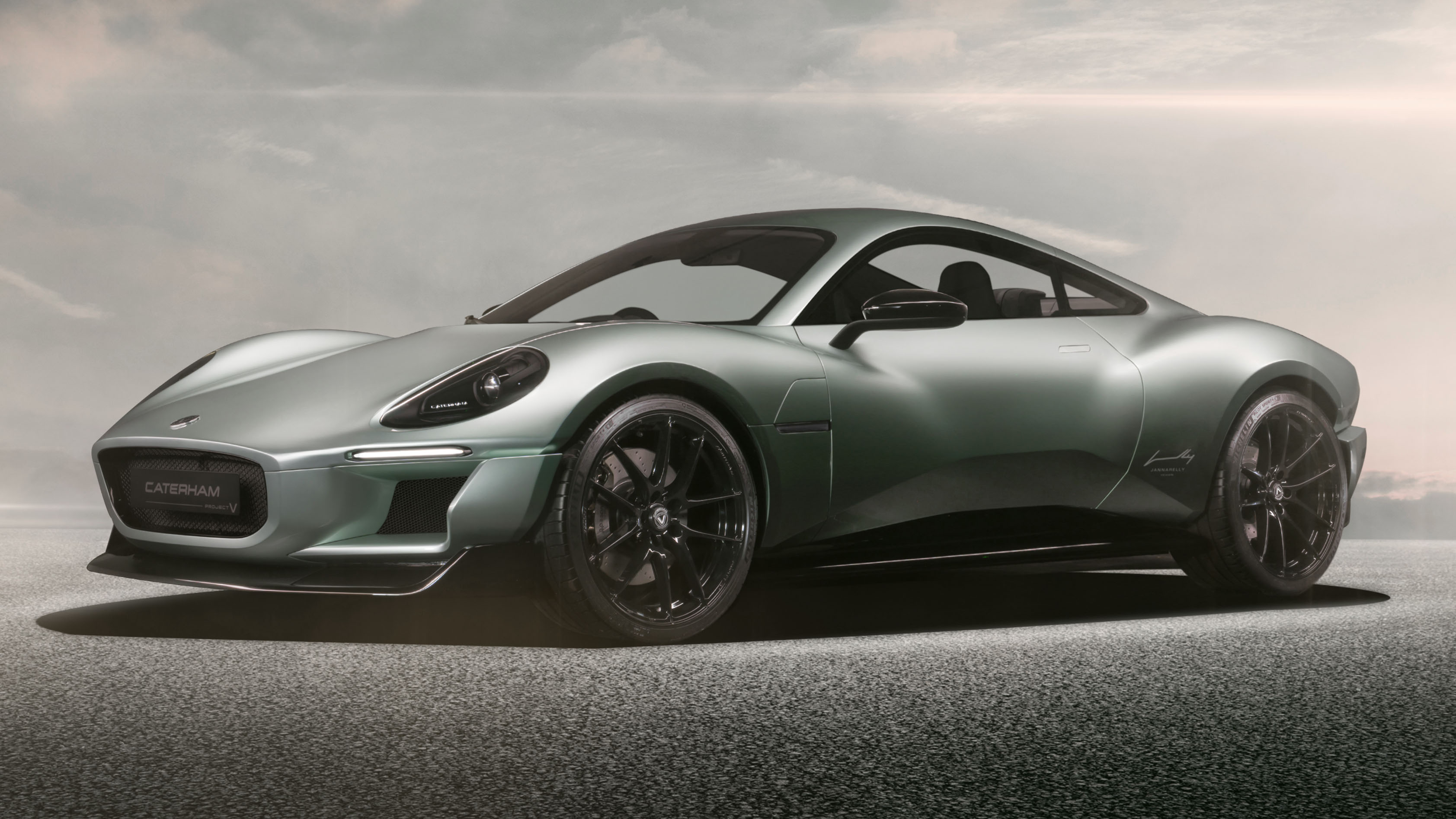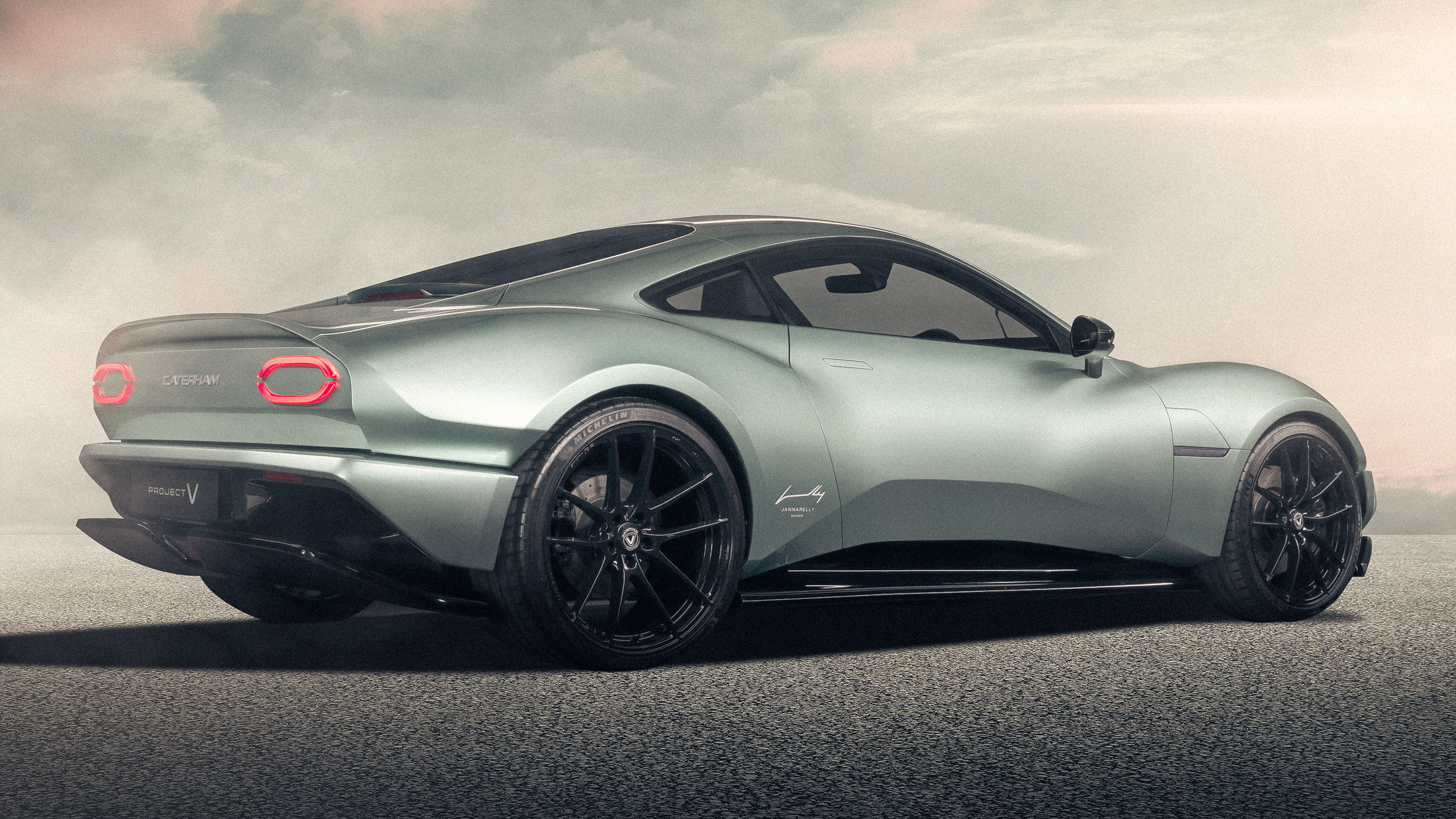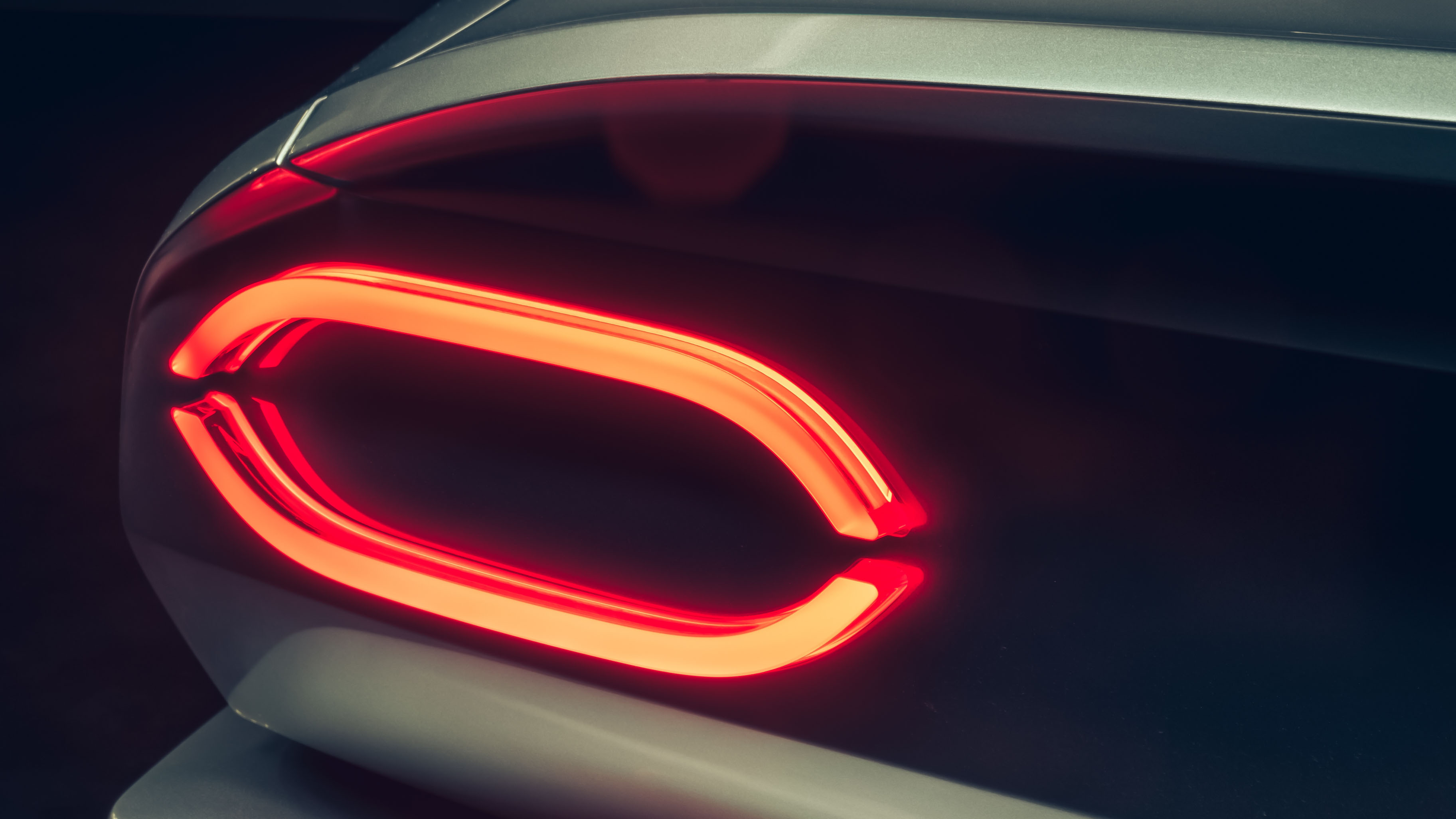
Caterham on the Project V sportscar: "we don't need to chase numbers"
Time to take a closer look at the future of Caterham: a lightweight *electric* sports car with a roof and proper handling...
Caterham CEO Bob Laishley seems pathologically wary of the usual political gibberish, a man whose media training amounts to saying – after he’s told you a juicy secret – “that should probably be off the record”. I like Bob a lot. He’s a straight talker and a terrible liar. But even he might have a bit of a job convincing diehard Caterham fans that an electric mini-supercar might well be the future of the brand. Although given the Project V, it might not be as hard as it sounds.
Mainly because the Project V – ‘V’ standing for voltage or velocity – is a pretty car in the metal, with a wasp waist and three bubble profile, strong shoulders and a simple rear end. There’s a distinct lack of 21in rims, Lambo doors and leather made from otter nipples, just an elegant silhouette and some muscular surfacing. It’s small, simple and the better for it.
The front has shades of Porsche, hints of the stillborn Caterham/Alpine C120, even the never quite there Caterham 21 of the mid-Nineties, a ghost of the Jannarelly Design 1. Although that’s not really that surprising, seeing as Caterham’s chief designer is actually... Anthony Jannarelly. But once you’re up close and personal, this is a car that has both character and proportion, intent but not fuss. It’s really rather excellent.
Saying that, it is quite the departure from the Seven, a car that circumvents fashion by being reliably unfashionable, barely changed in style since 1958 when Lotus first released the car into the wild, even if the mechanical specification doesn’t share a single part with those old stagers. But where the Seven still has cycle wings, a tent for a roof and a heater that parboils only your left knee, the Project V is entirely new ground for the company. It’s got a roof, for a start.
But that’s just the beginning of this story. The V is electric. Which makes 90 per cent of people who like sports cars wince and turn away slightly, even if they appreciate the possibilities. But it is also light, which also makes those very same people turn back. Bob says that the idea of the Project V is to be “simple, lightweight and fun to drive. And that’s the core DNA of every Seven... and what Caterham’s all about”. So how do you get from a simple Seven to a Project V?
Bob again: “First up, the Seven is going nowhere, and we’re committed to producing them well into the next decade with an internal combustion engine – this car is to complement that, not replace. But we have to grow the company. And that car has to better suit modern lifestyles.” In broad terms, that means something more usable. So you get an aluminium and composite chassis clothed in composite body panels, simple shapes and weight pared wherever a slice could be carved.
Weight really is the key here. Caterham reckons that with the 55kWh battery, roughly equitable with the cells you find in the average leccy family hatch, the Project V should come in at 1,190kg. That’s pretty good these days, exceptional for an electric car, and likely to get a little better over time as we pack more energetic mass into the same physical size of battery. When you consider that a lightweight ICE coupe like an Alpine A110 weighs in at around 1,100kg, you’re already only a big passenger away from weight parity. And lightweight begets efficiency – the less mass you have to move around means the brakes can be smaller, it needs less cooling, different crash protection. It’s a virtuous circle that electric cars often square.
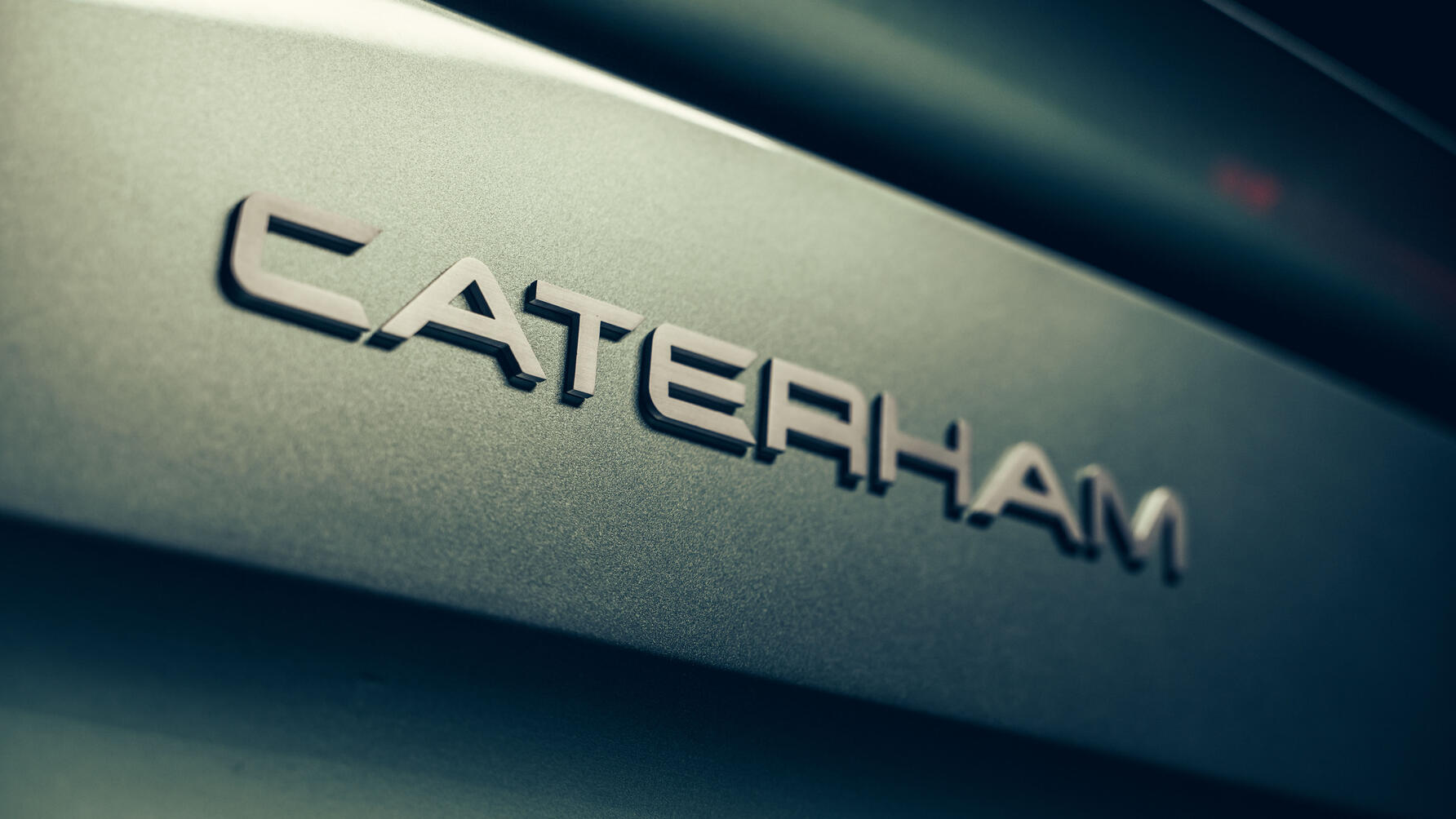
“Everything on the car has to justify itself from a weight perspective. We haven’t got a frunk – or a froot, as I prefer to call it – and that saves 10–12kg because we haven’t got seals, hinges, latches or the tray itself. The space it frees up gives us room to do what we need to do with the crash structure and the suspension placement,” says Bob. “We haven’t got an embedded infotainment system (just phone mirroring), and that means we haven’t got a double DIN structure somewhere in the car that takes up space and weight. These things don’t sound like much, but when you start doing it everywhere...”
But the real time thinking doesn’t stop there. You can build an electric car, especially a concept, that potentially belts physics around like a snooker ball in a sock. But the Project V hasn’t aimed for 1,000bhp, sub-2.0secs 0–62mph times or 250mph top speeds. There’s a single motor packaged near the rear axle, punting out a relatively modest 268bhp. That results in performance analogous – again – to something like an Alpine A110, so 0–62mph in 4.5 seconds and just over 140mph. Plenty to get yourself into trouble, not enough to have to re-engineer the car to be able to cope with largely theoretical usage. And leaving headroom for more hardcore variants in the future.
“The performance of this is like one of the 420S Sevens, we don’t need to chase the numbers – that’s old. We’re more about the dynamic performance of the car. This car isn’t focused towards a track day, but if it did end up on one, you don’t use that 0–60. You can’t use it in the pits, you’re more interested in performance around corners and that’s what we want to deliver with this,” says Bob, neatly inverting the usual electric car paradigm of being good at accelerating, but a bit numb around bends.
Top Gear
Newsletter
Thank you for subscribing to our newsletter. Look out for your regular round-up of news, reviews and offers in your inbox.
Get all the latest news, reviews and exclusives, direct to your inbox.
So the Project V seems to have taken a long look at what it means to be an electric driver’s car, and then made the adjustments within the parameters of the drivetrain. The suspension is fully adjustable so that you’ll be able to tailor the V to your preferred handling characteristics.
Most EVs ride high because the battery pack is usually packaged under the floor. Good for weight distribution and centre of gravity, bad for the driver, who tends to feel like they’re riding on, rather than in. Caterham’s solution is a split battery pack, with 50 per cent packaged up under your feet with the rest tucked up under the rear bench. That means your bottom and hips can be dropped lower in the seat, meaning you feel more tucked into the Project V rather than perched. It also means the roofline can be lower, the silhouette more slinky.
Inside is as refreshing as the outside. The dash is simple, clean and low. There’s a T-shaped centre console that spreads itself out across, with a pleasing lack of extraneous functions. Materials and quality look good, even on what is ‘just a concept’. Yes, there’s a touchscreen for Apple CarPlay and Android Auto phone mirroring, but it’s placed low in the centre console, above a set of toggle switches for things like windows and driving modes (Normal, Sport and Sprint). Presumably for doing the usual tweaks to aircon and throttle maps.
The wheel is tiny – very Caterham – and frames a pair of digital gauges in analogue styles, which nestle really nicely in your field of vision. But more interesting is that positioning of you in the car. The doors open wide enough, but you sit with your feet slightly high and your bum tilted back. More connected, and as intended, much lower than usual in an EV. That’s good for connection and response, the kind of driving you sense from your hips rather than something more obvious than, say, steering feel.
It’s roomy too, with enough headroom for those well over 6ft, and a rear bench (which houses half the batteries) which can in theory accommodate rear storage, a single or pair of rear jump seats, formed as pads on the bulkhead. The concept Project V has the single, centrally mounted rear seat, which looks cool, but anyone over 10 years old is going to struggle to get in or out. Or indeed, survive for long. But it’s a practical space which would swallow a couple of small suitcases no problem if you need more than the boot.
As for the other elements of practicality, that battery has active cooling/heating, which means a possible 249 miles of range, coupled with 150kW of onboard DC charging, which should offer 20–80 per cent charge in just 15 minutes, adding just under 150 miles of motivation. Plenty for most Caterham-type adventures. Which makes it all feel very... realistic, for what is supposed to be a concept car.
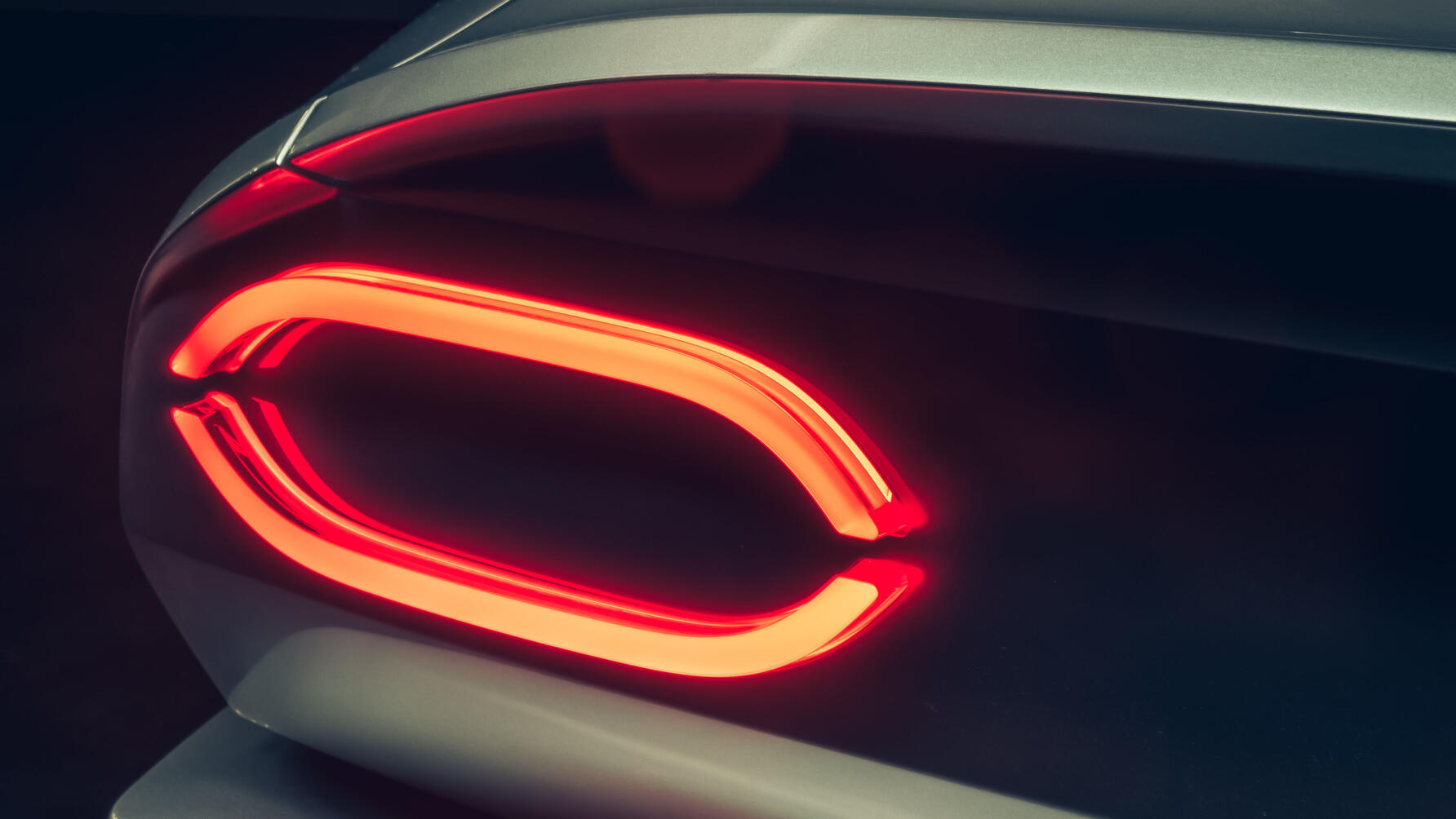
But as it turns out, there’s been a proper feasibility and engineering cost analysis on the Project V, so it’s not as concepty as you might imagine for a launch in ’25 or early 2026. “We’re a small company with limited resources – we can’t afford to do a show car, then throw it in the bin six months later and start to do the real engineering, so we started with real engineering and the car was manufactured by ItalDesign – because they’re part of big OEMs... we had access to all their tools. So this thing is packaged and mapped the way we wanted it.”
As for the cost, well, a projected price of around £80k certainly isn’t cheap for a Caterham, but for a baby supercar seems rather well priced. Obviously Porsche will be in the frame with the forthcoming electric Boxster/Cayman, but you get the feeling that, much like the Seven, there might be a market for those that place driving at the tip of their emotional spear, even if the powertrain is electric.
And that’s the real story here: Caterham is a nimble, small company with low volumes. It can take decisions quickly, strip back a car to core values, shuffle the pieces to create a vehicle that very well might hit its weight and performance targets. A company that’s clear in what it needs to produce in a world where the basic building blocks have morphed into something radically different.
Simple, lightweight and fun to drive. That's the core DNA... What we're all about
If Caterham can keep the Project V on target in terms of weight and price, keep the driving experience front and centre, there’s no reason this couldn’t be a standout. It can’t be a game changer with the numbers it’s talking about, but it could be a marker.
And the future? Well, when asked if Caterham was likely to expand (as Lotus has) into the realms of luxury saloons and SUVs, Bob simply said: “I haven’t seen you in a while. But I didn’t realise you’d suddenly become a comedian...” You get the feeling that Caterham, for all its quirks, is probably in safe hands. And the Project V suddenly doesn’t feel that much of a reach.
Trending this week
- Car Review
BMW iX3




